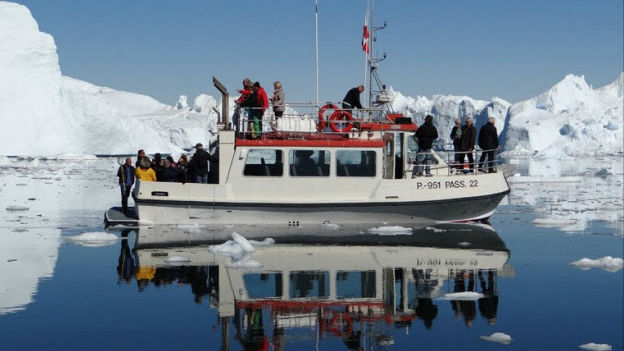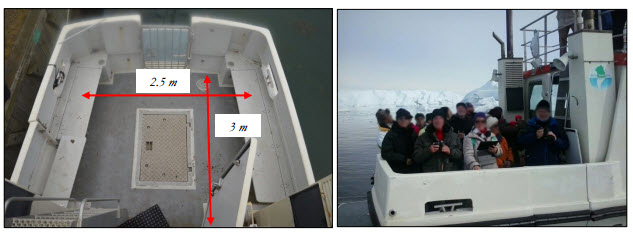Sinking Highlights Problems with Abstract Regulations

On August 14, 2016, the tour boat, Inuk II, sank in the bay of Ilulissat, Greenland. The 23 passengers were safely evacuated, wet and cold, onto another tour boat. However, the accident highlighted issues with the design and emergency procedures of such vessels.
The accident investigation conducted by the Danish Maritime Accident Investigation Board determined that the incident occurred because a hose connecting the aft deck drain to the discharge pipe was removed during removed and then not mounted again. On the day of the accident, Inuk II was transporting the maximum number of passengers which increased the draught to such an extent that the hull discharge pipe was submerged. Inuk II gradually lost all buoyancy as water flowed into the steering gear/storage compartment and subsequently into the engine room.
.jpg)
Inuk II was equipped with the mandatory lifesaving equipment and procedures and was manned with a crew who held valid certificates. However, the investigation into the accident showed that Inuk II’s designed ability to be successfully evacuated could be questioned because of the uncertainty caused by generic procedures and the little time available to evacuate the boat.
The maximum capacity of passengers was determined by the maritime authority on the basis of prescriptive legal requirements about the capacity in terms of space, seats and the available lifesaving equipment. However, the regulation was abstract in relation to how the equipment was to be utilized because there were no requirements for the content in the safety management manual or a requirement for any actual testing of the lifesaving equipment.
.jpg)
In order to bridge the gap between the prescriptive and the abstract requirements, the owner hired a consultant who had the necessary knowledge about how to make a safety management manual which could be approved by the maritime authority. However, the consultant had no knowledge about the operational realities of evacuating Inuk II and an actual test of the lifesaving equipment was not made. The result was a procedure for evacuation which was unusable for the crew members on Inuk II.
Lifejackets for the passengers were located under the seats in the passenger lounge and supplementary lifejackets for children were located in a compartment under the conning station together with the approved immersion suits of varying sizes. The immersions suits were of two different approved types: One type was a neoprene suit to be worn with a special type of underwear and not regular clothing. The other type could be donned with regular clothing. Both types were to be worn with a lifejacket.
There was no procedural or regulatory requirement for the boat to carry immersion suits for children. The regulation did not elaborate on the use of the immersion suits, i.e. were the passengers meant to jump into the sea wearing them, or were they to be used as warm clothes in the liferafts?
The safety management manual’s procedure for evacuation contained six stages:
1. The master of the ship reports to the coast radio station by VHF (mayday message). The GMDSS alarm button is to be activated.
2. All on board are brought on deck donned life jackets and are distributed between the ship’s life rafts.
3. The master of the ship takes command of a life raft.
4. The deck hand takes command of a life raft.
5. On the master’s command the life rafts are launched and inflated.
6. On the master’s command all on board are evacuated to the life rafts.
The prescriptive language used in the procedure indicated that the procedure was an instruction about how the evacuation was to be carried out, including a reference to when the lifejackets and the liferafts were to be used. There was no reference to the immersion suits in the safety management manual.
The procedure was seemingly specific about what the crew was supposed to do to achieve an effective evacuation, but the text did not include any reference to the circumstances that would cause the need for an evacuation, e.g. the boat being partly submerged, loss of stability, fire, etc. Thereby, the manual was designed with the underlying assumption that the boat was in a stable condition and did not reflect actual practical problems which crewmembers can experience in an actual emergency.
The issues became obvious during the sinking. The procedure did not address the boat’s worsening stability and the facts that the water on the aft deck hindered the passengers from mustering on the deck, the elderly passengers had problems climbing the bulwark, there was not sufficient time to don the lifejackets, etc.
The aft deck area was the only place with direct access to the inflated liferafts. The aft deck area was approximately 7.5 square meters (80 square feet) which gave 22 passengers about 0.3 square meters (3.2 square feet) each. The picture on the right below shows approximately 13-15 passengers on the aft deck. From the picture, it is evident that it would not be possible to accommodate all the passengers on deck while assisting them in donning the lifesaving equipment.
 The lack of space would have the implication that most of the passengers would have to be on standby in the passenger lounge if there should also be room for the crew members to inflate and secure the liferafts. In an adverse situation with fire, flooding or loss of stability, this scenario would result in a situation where the doorway to the passenger cabin would become a bottleneck where passengers would insist on having access to the deck area.
The lack of space would have the implication that most of the passengers would have to be on standby in the passenger lounge if there should also be room for the crew members to inflate and secure the liferafts. In an adverse situation with fire, flooding or loss of stability, this scenario would result in a situation where the doorway to the passenger cabin would become a bottleneck where passengers would insist on having access to the deck area.
The lack of integration and feedback between the maritime authority, the owner, the consultant and the crew members kept the problems associated with an evacuation hidden. It is therefore doubtful how effective the lifesaving equipment and procedures would be in an emergency not only on Inuk II, but also on other tour boats of similar size, passenger capacity and trading area, state the accident investigators.
The accident report is available here.
